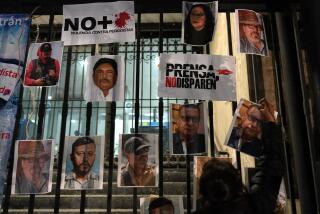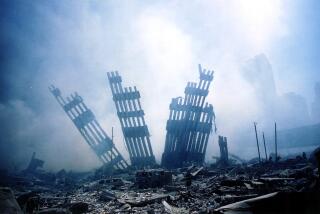Reporters’ Jumpy Reaction to Scud Attacks Seen as Firing Up the Iraqis : Media: Live television reports stir a debate. They may also play into the larger enemy strategy of disseminating terror.
- Share via
EASTERN SAUDI ARABIA — The drill has become familiar--first the sirens, then reporters in gas masks, followed by flashes in the sky. But some journalists here are becoming increasingly apprehensive that instantaneous media coverage of Iraq’s Scud missile attacks are distorting public perception of the war and perhaps even aiding the cause of Saddam Hussein.
Militarily, the Scud attacks are not particularly significant, authorities from the allied forces keep suggesting. But because they are happening where reporters are located, they tend to dominate what the public sees of the war.
As a result, some reporters worry, the constant coverage of journalists obviously frightened by Scud attacks that in fact have done little damage may be boosting the morale of Iraqi army officers at Scud batteries, where gunners can see that they are stirring up anxiety. Perhaps the reports and television pictures of recognizable features of Saudi cities might assist the Iraqis in targeting the missiles.
And they may be playing into the hands of Hussein’s larger military strategy, in which the Scud is more an instrument of political terror than physical destruction.
“That logic carried to its conclusion would not have us report much of anything that could be seen as negative for the allied coalition,” countered Ed Turner, executive vice president of Cable News Network.
The question of assessing consequences and fending off manipulation are standard stuff for reporters. So is the paradox that news is whatever happens in the vicinity of a journalist.
Nonetheless, tempers are fraying, even within the press. On Tuesday, two print reporters scuffled with a television cameraman in Dhahran as he tried to film journalists headed for a bomb shelter in Dhahran. The cameraman was blocking their way to the bomb shelter, putting what the print reporters considered an insignificant picture in the way of what might be some personal danger.
The controversy comes at a time when the media are also under pressure over how to deal with the continuing Iraqi broadcasts of Western prisoners of war.
One network, ABC, even has a policy of not broadcasting the audio portion, a reflection in part of its own experience in having one of its correspondents held hostage in Lebanon. After his release, ABC correspondent Charles Glass said that airing the tape of his statements, which was made under threat of violence, played into the hands of his captors.
The other major networks all aired portions of the audio statements by the POWs, apparently made under duress. Many newspapers, including the Los Angeles Times, used the statements in their Page 1 stories.
But it is the Scud missile reports that seem to have divided the press corps. Even Pete Williams, the assistant secretary of defense for public affairs and a former journalist, seemed torn. “If I had the capability to go live and missiles were coming at me, I’d go live,” he said Tuesday.
CBS made a decision that it would no longer break into regular programming to cover Scud missile attacks after the first one on Monday night. Instead, it will wait and see how significant they turn out to be.
The other two major commercial networks now have similar policies. But CNN, the 24-hour, all-news operation and the one U.S. network seen in the Middle East, is more likely to go live when a Scud attack occurs, CNN officials indicated.
The issue came to a head Tuesday morning after yet another air raid warning in Dhahran. CNN turned to a live report from Charles Jaco, who, over the scream of the air raid sirens, informed viewers that he knew only that an alarm had gone off and that under new Saudi restrictions, his cameras could not show anything other than the wall behind him.
Despite the lack of either information or pictures, the CNN anchor continued to shoot questions at the obviously nervous Jaco as he stood in the open, repeatedly mopping his brow and occasionally twitching. At one point, as Jaco apparently caught a whiff of jet exhaust, he suddenly dove and slammed a gas mask over his face, handing the microphone to a colleague who, without gas mask, talked about how nervous people were and tried to reassure Jaco that his anxiety was understandable.
Interviewed later, Jaco said he had heard criticism from colleagues and acknowledged that “there were times I’ve blown it. . . . It disturbs me a lot, those that think I’m increasing the fear. I’ve got a family back home, too.”
At the same time, though, Jaco said CNN received “hundreds, hundreds of calls” from residents of Saudi Arabia and journalists themselves who said they had come to rely on the live broadcasts of a threatened attack for keeping them informed in a city with otherwise spotty air raid warnings.
Howell Raines, Washington bureau chief of the New York Times, blames any overemphasis on Scuds on the Pentagon. “There is a problem in general of balance, coherence and focus in covering this war, and those problems proceed in the main from the Bush Administration decision not to have anything approaching a reasonable level of access to information. The consequence is we have these snapshots of a small part of the theater.”
Some network executives say that there are legitimate reasons for covering the Scud attacks, in some form, as they are happening. John Terenzio, executive producer of news specials at NBC, said, “The reason there is so much interest is that the Scud is the only (offensive) weapon Saddam Hussein has unleased. I suspect that if there is a wider war in the air and on the ground, and he utilizes many many other weapons, that we will come to hear very little about Scud missiles.”
Rosenstiel reported from Washington and Balzar from Saudi Arabia. Doug Frantz, Melissa Healy and David Lauter contributed to this report.
More to Read
Sign up for Essential California
The most important California stories and recommendations in your inbox every morning.
You may occasionally receive promotional content from the Los Angeles Times.













